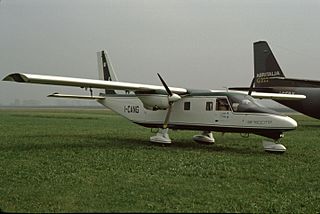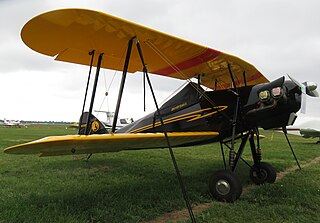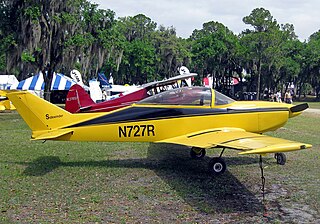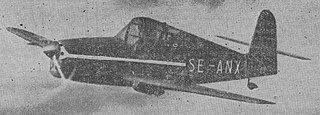| JW-1 Jetwing | |
|---|---|
 | |
| Role | Research aircraft |
| Manufacturer | Ball-Bartoe |
| Designer | Otto Bartoe |
| First flight | 11 July 1977 |
| Number built | 1 |



The Ball-Bartoe JW-1 Jetwing was a US research aircraft flown in the 1970s to investigate blown wing technology.
| JW-1 Jetwing | |
|---|---|
 | |
| Role | Research aircraft |
| Manufacturer | Ball-Bartoe |
| Designer | Otto Bartoe |
| First flight | 11 July 1977 |
| Number built | 1 |



The Ball-Bartoe JW-1 Jetwing was a US research aircraft flown in the 1970s to investigate blown wing technology.
The Jetwing was a small, mid-wing design powered by a turbofan and fitted with tail-wheel undercarriage. The upper surface of the swept wings incorporated a slot along 70% span, through which air from the engine's fan stage could be discharged. Mounted above this slot was a small secondary airfoil called an "augmentor", intended to direct the discharged airflow over the wing. With this arrangement, it was found that the aircraft remained controllable at airspeeds as low as 34.76 kn (64.38 km/h; 40.00 mph).
Following the test program, the aircraft was donated to the University of Tennessee Space Institute in Tullahoma, which donated the Jetwing to the Wings Over the Rockies Air and Space Museum in Denver, Colorado in 2007.
Data from [1]
General characteristics
Performance

The Piaggio PD.808 was an Italian business jet built by Piaggio. It was designed as a joint venture between Piaggio and Douglas Aircraft Company of Long Beach, California, United States.

The Schempp-Hirth Discus is a Standard Class glider designed by Schempp-Hirth. It was produced in Germany between 1984 and 1995 but has continued in production in the Czech Republic. It replaced the Standard Cirrus. It was designed by Klaus Holighaus.

The Schempp-Hirth Janus is a high performance two-seat glider that was built by Schempp-Hirth GmbH. It was the first high-performance two-seater.

The Schleicher ASW 15 is a single-seat sailplane designed in 1968 by Gerhard Waibel and manufactured by Alexander Schleicher GmbH & Co. The ASW 15 has shoulder-mounted wings and an all-flying tailplane, with its single tow-release placement a compromise between winching and aerotowing. The later ASW 15B had several improvements, including a tow-release placed on the plane of symmetry, an 11 cm taller rudder, a slightly larger main wheel, and the provision of a 90-litre water ballast system.

The Dassault Mystère/Falcon 10 is an early corporate jet aircraft developed by French aircraft manufacturer Dassault Aviation. Despite its numbering sequence it was actually developed after the Falcon 20, and although it is sometimes considered as a scaled-down version of that aircraft, it was totally redesigned with a non-circular fuselage, a new wing with slotted flaps, a split passenger door and many simplified circuits compared to the Falcon 20.

The Albatros L 75 Ass was a German trainer biplane of the 1920s. Of conventional configuration, it seated the pilot and instructor in separate, open cockpits. The wings were single-bay, equal-span, and had a slight stagger. Production continued after Albatros was absorbed by Focke-Wulf.
The Anderson EA-1 Kingfisher is a US two-seat amphibious aircraft designed and marketed for homebuilding. It was the work of Earl William Anderson, a Pan Am airline captain, who flew the prototype on 24 April 1969. By 1978, 200 sets of kits for the plane had been sold, and 100 Kingfishers were reported to be under construction. The aircraft is a shoulder-wing monoplane with a flying boat hull and outrigger pontoons. On land, it uses retractable tailwheel undercarriage. The single engine with a tractor propeller is mounted in a nacelle above the wing. Some builders utilize the wings from a Piper Cub rather than making their own.

The Gulfstream American Hustler was a 1970s American mixed-power executive/utility aircraft designed by American Jet Industries, which later changed to Gulfstream American Corporation. The aircraft had a nose-mounted turboprop and a tail-mounted turbofan.

The VSO 10 Vosa is a Standard and Club-Class glider designed and manufactured in the Czechoslovak Republic from December 1978 as a replacement for the VT-116 Orlik II.

The Fokker C.VII-W was a reconnaissance seaplane built in the Netherlands in the late 1920s. Sharing elements of the highly successful C.V design, the C.VII-W was a conventional, single-bay biplane with wings of unequal span braced with N-struts. The undercarriage consisted of a standard twin-pontoon arrangement, and the fin and rudder continued through to the ventral side of the fuselage, creating a cruciform tail. The pilot and observer sat in tandem, open cockpits. The wing structure was wooden with fabric and plywood covering, and the fuselage was of steel tube construction with fabric covering.

The Vulcanair SF.600 Canguro was a feederliner developed in Italy in the late 1970s. Despite a number of attempts to put the aircraft into series production, only a small number were ever built. The Canguro was a high-wing cantilever monoplane of conventional configuration with a fuselage of rectangular cross-section and a high-set tail. The tricycle undercarriage was not retractable, and its main units were carried on sponsons on the fuselage sides. SIAI Marchetti provided funding towards the construction of the prototype, and constructed this aircraft at the former Aviamilano plant. After flight testing proved positive, the type was put on sale, but failed to attract buyers in any number, even when the original piston engines were exchanged for turboprops and retractable undercarriage was offered as an option.

The Gulfstream American Peregrine 600 was a military trainer aircraft developed in the United States in the early 1980s but which did not progress further than prototype stage. Developed from the company's Hustler business aircraft, the Peregrine shared the same wings, empennage and rear fuselage, but had a new forward fuselage with side-by-side seating for the pilot and instructor. The aircraft was developed as a contender in the United States Air Force's Next Generation Trainer program, but was ultimately passed over in favor of the Fairchild T-46. Attempts to market it to the air forces of Australia, New Zealand, Japan, and China also proved unsuccessful, and the project was canceled in 1985. The wing and rear fuselage design was incorporated in the Gulfstream Aerospace Peregrine business aircraft.

The Promavia F.1300 Jet Squalus, also known as Promavia Jet Squalus F1300, was a two-seat light jet trainer designed by Italian Stelio Frati and built by Promavia in Belgium with support from the Belgian government.
The Renard R.17 was a Belgian four-seat cabin monoplane designed and built by Constructions Aéronautiques G. Renard. The high cantilever wing was an unusual feature when most contemporary aircraft still had braced wings. Designed as a high-speed transport for fresh flowers, no aircraft were ordered and the only R.17 was retained by the company until 1946.

The SZD-48 Jantar Standard 2 is a Standard Class glider that was designed and produced in Poland starting in 1977.

The Skyote Aeromarine Skyote is a single-engine, single-seat sport biplane designed in the 1970s in the United States and marketed as plans and kits for homebuilding.

The Smyth Model S Sidewinder is an all-metal, two-seat side-by-side, low-wing homebuilt aircraft, designed and developed in the United States.

The Skandinaviska Aero BHT-1 Beauty is a 1940s Swedish single-seat light monoplane designed by E. Bratt, K.E. Hilfing and B.Törnblom and built by Skandinaviska Aero of Stockholm.

The Fairchild 228 was a regional jet developed for the United States market by Fairchild Hiller using Fokker F28 sub-assemblies.
The Akaflieg Darmstadt D-39 was a single-seat motor glider derived from the D-38 sailplane. Built in Germany in the late 1970s, it was not intended for production and only one was constructed.